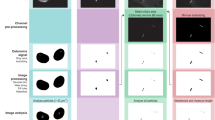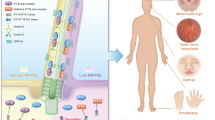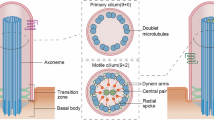Abstract
Ciliopathies are rare genetic diseases marked by considerable phenotypic heterogeneity and overlap. Among the key mechanisms of cilium biology, its compartmentalization is achieved through gating complexes and active transport such as intraflagellar transport (IFT). Among the IFT components, IFT27 plays a role in BBSome-mediated transport of ciliary membrane proteins required for ciliary signaling. While this gene was first linked to Bardet-Biedl syndrome, we next expanded its phenotypic spectrum to a fetal lethal ciliopathy. Here, we identified a second fetal case with short ribs, polydactyly, hypodysplastic kidneys, imperforate anus, and situs inversus. Genome sequencing identified novel biallelic variants in IFT27. Functional analysis of tissues from both fetal cases revealed that all the identified variants lead to mRNA decay. Immunohistochemistry on fetal kidney sections showed that those variants are associated with altered ciliogenesis. Overall, we showed that complete loss of IFT27 function leads to a severe phenotypic spectrum overlapping with short ribs polydactyly and Pallister-Hall syndromes. In addition, our results argue for a role of IFT27 in ciliogenesis in humans.
This is a preview of subscription content, access via your institution
Access options
Subscribe to this journal
Receive 12 print issues and online access
$259.00 per year
only $21.58 per issue
Buy this article
- Purchase on SpringerLink
- Instant access to full article PDF
Prices may be subject to local taxes which are calculated during checkout


Similar content being viewed by others
Data availability
The datasets generated during the current study are available in the ClinVar repository, https://www.ncbi.nlm.nih.gov/clinvar/; VCV000591265.5 and VCV001069785.5.
References
Hildebrandt F, Benzing T, Katsanis N. Ciliopathies. N Engl J Med. 2011;364:1533–43.
Bachmann-Gagescu R. Complexité génétique des ciliopathies et identification de nouveaux gènes. Med Sci. 2014;30:1011–23.
Park K, Leroux MR. Composition, organization and mechanisms of the transition zone, a gate for the cilium. EMBO Rep. 2022;23:e55420.
Garcia-Gonzalo FR, Corbit KC, Sirerol-Piquer MS, Ramaswami G, Otto EA, Noriega TR, et al. A transition zone complex regulates mammalian ciliogenesis and ciliary membrane composition. Nat Genet. 2011;43:776–84.
Qin H, Wang Z, Diener D, Rosenbaum J. Intraflagellar transport protein 27 Is a small G protein involved in cell-cycle control. Curr Biol. 2007;17:193–202.
Jin H, White SR, Shida T, Schulz S, Aguiar M, Gygi SP, et al. The conserved Bardet-Biedl syndrome proteins assemble a coat that traffics membrane proteins to cilia. Cell. 2010;141:1208–19.
Loktev AV, Zhang Q, Beck JS, Searby CC, Scheetz TE, Bazan JF, et al. A BBSome subunit links ciliogenesis, microtubule stability, and acetylation. Dev Cell. 2008;15:854–65.
Nachury MV, Loktev AV, Zhang Q, Westlake CJ, Peränen J, Merdes A, et al. A core complex of BBS proteins cooperates with the GTPase Rab8 to promote ciliary membrane biogenesis. Cell. 2007;129:1201–13.
Aldahmesh MA, Li Y, Alhashem A, Anazi S, Alkuraya H, Hashem M, et al. IFT27, encoding a small GTPase component of IFT particles, is mutated in a consanguineous family with Bardet-Biedl syndrome. Hum Mol Genet. 2014;23:3307–15.
Schaefer E, Delvallée C, Mary L, Stoetzel C, Geoffroy V, Marks-Delesalle C, et al. Identification and characterization of known biallelic mutations in the IFT27 (BBS19) gene in a novel family with Bardet-Biedl syndrome. Front Genet. 2019;10:21.
Zhou Z, Qiu H, Castro-Araya RF, Takei R, Nakayama K, Katoh Y. Impaired cooperation between IFT74/BBS22–IFT81 and IFT25–IFT27/BBS19 causes Bardet-Biedl syndrome. Hum Mol Genet. 2022;31:1681–93.
Nawaz H, Mujahid, Khan SA, Bibi F, Waqas A, Bari A, et al. Biallelic variants in seven different genes associated with clinically suspected Bardet-Biedl syndrome. Genes. 2023;14:1113.
Quélin C, Loget P, Boutaud L, Elkhartoufi N, Milon J, Odent S, et al. Loss of function IFT27 variants associated with an unclassified lethal fetal ciliopathy with renal agenesis. Am J Med Genet Pt A. 2018;176:1610–3.
Potter EL. Facial characteristics of infants with bilateral renal agenesis. Am J Obstet Gynecol. 1946;51:885–8.
Powers KT, Szeto JYA, Schaffitzel C. New insights into no-go, non-stop and nonsense-mediated mRNA decay complexes. Curr Opin Struct Biol. 2020;65:110–8.
Morris C, Cluet D, Ricci EP. Ribosome dynamics and mRNA turnover, a complex relationship under constant cellular scrutiny. Wiley Interdiscip Rev RNA. 2021;12:e1658.
Sanchez-Navarro I, R. J. Da Silva L, Blanco-Kelly F, Zurita O, Sanchez-Bolivar N, Villaverde C, et al. Combining targeted panel-based resequencing and copy-number variation analysis for the diagnosis of inherited syndromic retinopathies and associated ciliopathies. Sci Rep. 2018;8:5285.
Eguether T, San Agustin JT, Keady BT, Jonassen JA, Liang Y, Francis R, et al. IFT27 links the BBSome to IFT for maintenance of the ciliary signaling compartment. Dev Cell. 2014;31:279–90.
Florea L, Caba L, Gorduza EV. Bardet–Biedl syndrome—multiple Kaleidoscope images: insight into mechanisms of genotype–phenotype correlations. Genes 29 août. 2021;12:1353.
Dagoneau N, Goulet M, Geneviève D, Sznajer Y, Martinovic J, Smithson S, et al. DYNC2H1 mutations cause asphyxiating thoracic dystrophy and short rib-polydactyly Syndrome, type III. Am J Hum Genet. 2009;84:706–11.
Thiel C, Kessler K, Giessl A, Dimmler A, Shalev SA, Von Der Haar S, et al. NEK1 Mutations cause short-rib polydactyly syndrome type Majewski. Am J Hum Genet. 2011;88:106–14.
Démurger F, Ichkou A, Mougou-Zerelli S, Le Merrer M, Goudefroye G, Delezoide AL, et al. New insights into genotype–phenotype correlation for GLI3 mutations. Eur J Hum Genet. 2015;23:92–102.
Acknowledgements
The authors are grateful to the families involved in this study and would like to thank the French Society of Fetal Pathology (SOFFOET).
Funding
This work was supported by grants from the “Agence Nationale de la Recherche” (ANR) to S.T. (ANR-17-CE16-0003-01). The Imagine Institute is funded by the ANR under the “Investissements d’Avenir” program (ANR-10-IAHU-01) and as part of the second “Investissements d’Avenir” program (ANR-17-RHUS-0002).
Author information
Authors and Affiliations
Contributions
Study conception: TAB; data acquisition: all authors; manuscript drafting: DH, ST, TAB; manuscript revision, editing, and approval: all authors.
Corresponding authors
Ethics declarations
Competing interests
The authors declare no competing interests.
Ethical approval
Medical terminations of pregnancy were performed in accordance with French law and with approval from our local committee. Autopsies were conducted after informing and obtaining written consent from the parents. The parents also provided informed consent for genetic testing, and the study was approved by the ethical committee of Paris Ile-de-France II.
Additional information
Publisher’s note Springer Nature remains neutral with regard to jurisdictional claims in published maps and institutional affiliations.
Rights and permissions
Springer Nature or its licensor (e.g. a society or other partner) holds exclusive rights to this article under a publishing agreement with the author(s) or other rightsholder(s); author self-archiving of the accepted manuscript version of this article is solely governed by the terms of such publishing agreement and applicable law.
About this article
Cite this article
Haïm, D., Roux, N., Boutaud, L. et al. Complete loss of IFT27 function leads to a phenotypic spectrum of fetal lethal ciliopathy associated with altered ciliogenesis. Eur J Hum Genet 33, 387–392 (2025). https://doi.org/10.1038/s41431-025-01810-3
Received:
Revised:
Accepted:
Published:
Issue date:
DOI: https://doi.org/10.1038/s41431-025-01810-3
This article is cited by
-
Spring in EJHG
European Journal of Human Genetics (2025)
-
SDC4 drives fibrotic remodeling of the intervertebral disc under altered spinal loading
Cell Death & Disease (2025)



